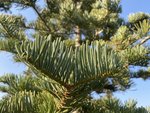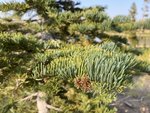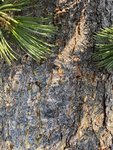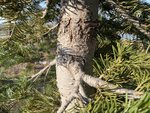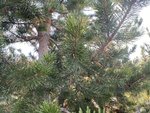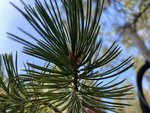You are using an out of date browser. It may not display this or other websites correctly.
You should upgrade or use an alternative browser.
You should upgrade or use an alternative browser.
Help with identifying trees
- Thread starter mudvein
- Start date
CWTurner
Omono
hinmo24t
Masterpiece
could be wrong. ponderosa?
Thx... no not Ponderosa. I grow Ponderosa regularly and they normally have 3 needle groups that are much longercould be wrong. ponderosa?
Thx... I think it might be too, but can’t tell 100%The second one looks like limber pine to my untrained eye.
I found This Site when I looked it up.
CW
Leo in N E Illinois
The Professor
- Messages
- 11,341
- Reaction score
- 23,292
- USDA Zone
- 5b
First one, possible fir. Check and look for remnants of cones. Firs, the cones point up, the cones sit on the top side of branches. FIr cones disintegrate after seed is ripe. Needles tend to be blunt & flattened for fir. Spruce the cones hang below the branch. The cones can hang on a season or two after the seed is ripe. The cones "point down". Needles tend to be sharply pointed, though not always. Which fir you have? I don't know. Abies concolor and Abies lasiocarpa are both native to Oregon, but their ranges don't seem to overlap. In a location, you have one, or the other. Both have range overlap at 7,000 feet. A. lasiocarpa tends to be at or above 7,000 feet, and Abies concolor tends to be at or below 7,000 Feet.
Second one, the pine, my first guess would be western white pine - Pinus monticola - which is found in central and eastern Oregon, or Pinus albicaulis the white bark pine - the whitebark pine has very limited distribution in Oregon, but it does occur in the Northeast corner of Oregon, or it could be sugar pine - Pinus lambertiana, but lambertiana is mainly found in Western Oregon, not eastern Oregon, if the range maps are accurate. It is unlikely to be limber pine, Pinus flexilis, because flexilis is not found in Oregon.
SO for the #2, the pine, my stronger guess is Western White Pine, Pinus monticola.
I do not think it is one of the bristlecones. I see no resin channels on the needles. The "foxtails" of foliage are not as pronounced as I would expect for a bristlecone.
FOr pines, details of where prickles occur or don't occur on cones is often key to separating species. It is beyond my depth, but just going by Wikipedia I would say #2 is Pinus monticola.
Second one, the pine, my first guess would be western white pine - Pinus monticola - which is found in central and eastern Oregon, or Pinus albicaulis the white bark pine - the whitebark pine has very limited distribution in Oregon, but it does occur in the Northeast corner of Oregon, or it could be sugar pine - Pinus lambertiana, but lambertiana is mainly found in Western Oregon, not eastern Oregon, if the range maps are accurate. It is unlikely to be limber pine, Pinus flexilis, because flexilis is not found in Oregon.
SO for the #2, the pine, my stronger guess is Western White Pine, Pinus monticola.
I do not think it is one of the bristlecones. I see no resin channels on the needles. The "foxtails" of foliage are not as pronounced as I would expect for a bristlecone.
FOr pines, details of where prickles occur or don't occur on cones is often key to separating species. It is beyond my depth, but just going by Wikipedia I would say #2 is Pinus monticola.
Leo in N E Illinois
The Professor
- Messages
- 11,341
- Reaction score
- 23,292
- USDA Zone
- 5b
# 3 vaguely looks like Pseudotsuga - Douglas Fir. But I am not certain.
0soyoung
Imperial Masterpiece
The fir looks like white fir (abies concolor).
Western white pine (p. monticola) has needles like p. strobus (eastern white pine), but uniquely has 4 white stomatal lines. The needles look to be too coarse and to not have the distinct white lines. So, I support @CWTurner's opinion that the 5-needle pine is a limber pine (p. flexilis).
The 2-needle could be a lodgepole (p. contorta).
Western white pine (p. monticola) has needles like p. strobus (eastern white pine), but uniquely has 4 white stomatal lines. The needles look to be too coarse and to not have the distinct white lines. So, I support @CWTurner's opinion that the 5-needle pine is a limber pine (p. flexilis).
The 2-needle could be a lodgepole (p. contorta).
The fir looks like white fir (abies concolor).
Western white pine (p. monticola) has needles like p. strobus (eastern white pine), but uniquely has 4 white stomatal lines. The needles look to be too coarse and to not have the distinct white lines. So, I support @CWTurner's opinion that the 5-needle pine is a limber pine (p. flexilis).
The 2-needle could be a lodgepole (p. contorta).
Thank you... I'm going to do a lot more research on Limber Pine. I appreciate the details you provided.
Leo in N E Illinois
The Professor
- Messages
- 11,341
- Reaction score
- 23,292
- USDA Zone
- 5b
Thank you... I'm going to do a lot more research on Limber Pine. I appreciate the details you provided.
Again, I will point out that at least Wikipedia says limber pine is NOT native to Oregon. Now that may or may not be correct. But if it is not native to the area, why would you assume that is the species you have?
Again, I will point out that at least Wikipedia says limber pine is NOT native to Oregon. Now that may or may not be correct. But if it is not native to the area, why would you assume that is the species you have?
I’m not assuming anything... thus the research on trees I saw in a forest. Based on some sites it looks like Limber Pine does grow in portions of Oregon
0soyoung
Imperial Masterpiece
P. albicaulis, white bark pine, is another possibility limber. Its 5 needles are 1.5 to 3 inches long and definitely is native to OR.
According to Oregon State U., there are isoloated populations of flexilis in NE OR. Flexilis 5 needles are about the same size, maybe more like 3 inches on average.
btw, Douglas fir foliage is like a soft spruce.
According to Oregon State U., there are isoloated populations of flexilis in NE OR. Flexilis 5 needles are about the same size, maybe more like 3 inches on average.
btw, Douglas fir foliage is like a soft spruce.
P. albicaulis, white bark pine, is another possibilitylimber. Its 5 needles are 1.5 to 3 inches long and definitely is native to OR.
According to Oregon State U., there are isoloated populations of flexilis in NE OR. Flexilis 5 needles are about the same size, maybe more like 3 inches on average.
btw, Douglas fir foliage is like a soft spruce.
Yes... I agree... could definitely be white bark pine
Thx
Found this info on Whitebark pine very interesting https://www.fws.gov/oregonfwo/articles.cfm?id=149489519
Leo in N E Illinois
The Professor
- Messages
- 11,341
- Reaction score
- 23,292
- USDA Zone
- 5b
Okay, I read the bit on Oregon. This leaves the question, were you in or near the Wallowa Mountain range in OR, or were you more than a hundred miles away.
When you hear horse hoofs coming down the hall, its probably not zebras.
Plant distributions are not random. P. monticola is native to a wide area of Oregon, P. flexilis is native to only a relatively small area. At least if the "books" can be trusted.
Get yourself a dichotomous key, and key out which species you have. State of Oregon dept of natural history or Forestry Service should have a key on line that is specific for Oregon.
0soyoung
Imperial Masterpiece
Tree species distribution map. Not 100% accurate, as there are no natural acer circinatum on any of the islands, Fidalgo, Whidbey, Camano, and the official San Juans. Cross a narrow strip of salt water and they exist all over and well up into the Cascades, for example. The map also shows pinus monticola on Fidalgo. There were many in the forest lands about a century ago but I'm pretty well convinced the species was wiped out by the white pine blister rust (Cronartium ribicola) over 50 years ago. It also indicates that the juniperus scopulorum that are on Fidalgo aren't here (but my lying eyes say the species is here naturally). The species is indeed in abundance in the San Juans as shown.
Nevertheless, reasonably good to make plausibility checks and a nice listing of native species (your results may vary
 ),
),
Nevertheless, reasonably good to make plausibility checks and a nice listing of native species (your results may vary
Last edited:
Potawatomi13
Imperial Masterpiece
#1 definitely true fir Abies. Personally do not know Abies subspecies well
#2 Not likely to be P. flexilis as only happens in tiny area of Wallowa mtns. Could be P. lambertiana, P. monticola or P. albicaulis. Cones as well as location tell the story.
#3 Lodgepole Pine
As to first two trees specific location and cones likely needed except for forester that can tell by needles .
.
#2 Not likely to be P. flexilis as only happens in tiny area of Wallowa mtns. Could be P. lambertiana, P. monticola or P. albicaulis. Cones as well as location tell the story.
#3 Lodgepole Pine
As to first two trees specific location and cones likely needed except for forester that can tell by needles
Potawatomi13
Imperial Masterpiece
Found this info on Whitebark pine very interesting https://www.fws.gov/oregonfwo/articles.cfm?id=149489519
Please add personal location to profile. Are you native or transplant?
Similar threads
- Replies
- 17
- Views
- 1K

